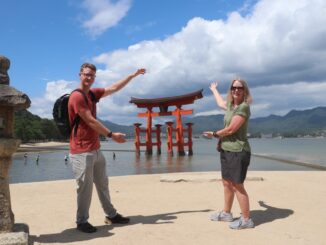HIROSHIMA, Japan – For students of history and travelers looking to see and understand what happened here, to Japan and to the whole world on that day, there are several memorials located in Peace Memorial Park in the center of the city near the bomb’s hypocenter and dedicated to the bombing – including the Peace Flame. The Flame of Peace has burned since it was completed on Aug. 1, 1964, and it will remain lit until all atomic weapons are eliminated from the planet.
The Industrial Promotion Hall was completed on April 5, 1915, and was located near the bomb’s hypo-center. It is one of the few buildings to survive the blast. Historic photographs of the city show a landscape flattened by the blast, with just a few structures still standing — one being the shell of the Industrial Promotion Hall. But, the building is just one of a few important landmarks dedicated to Aug. 6, 1945.
The nearby Atomic Bomb Memorial Mound holds the ashes of 70,000 unidentified people who were killed in the bombing, a solemn reminder of that fateful day. The Cenotaph for the A-Bomb Victims (also known as the Memorial Monument for Hiroshima, City of Peace) includes a stone chest with the names of everyone known to have been killed by the bomb.
The Industrial Promotion Hall, today known as the A-Bomb Dome, is a tourist attraction, but first and foremost for the people of Hiroshima, it’s the center of plea for peace and the focal point of a calling to eliminate all atomic weapons from the face of the Earth. It’s a bit peculiar to think of this as a tourist attraction.
Why do people come here? The answer is hard to define.
Perhaps the centerpiece of Peace Park is the Hiroshima Peace Memorial Museum, providing a detailed overview of Hiroshima before and after the blast. The museum houses artifacts recovered from the city, maps showing what the city looked like on the day of the blast and information about the Manhattan Project and the development of the atomic bomb.
The museum does a decent job of putting the bomb into the context of World War II, and it is clear that it was Japan that preemptively bombed Pearl Harbor and brought the U.S. into War. The museum also lays out some of Japanese aggression throughout Asia leading up to World War II. Still, it’s important to note that the museum tells about the bombing from a Japanese perspective and tries to paint the country in the best possible light.



